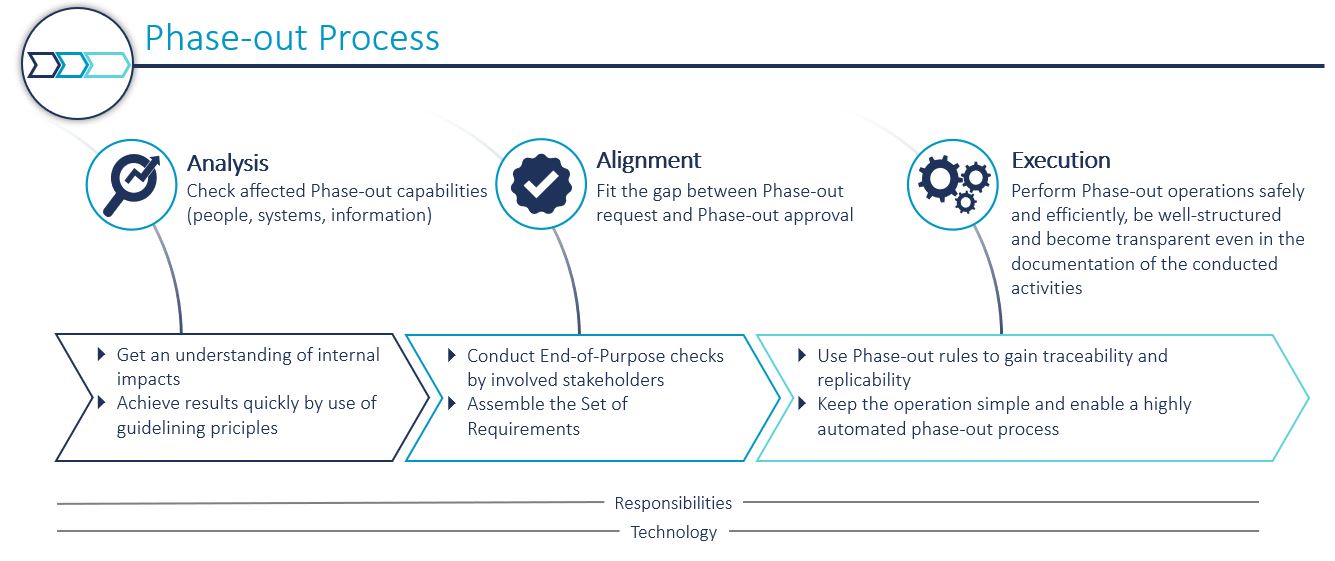IT landscapes and gathered information have become more complex in recent years. Huge efforts in controlling information are necessary, if specific information reaches the end of its lifecycle. The impacts of automated deletion can hardly be evaluated. Even daily business is affected by defective decommissioning of information systems or inconvenient archiving procedures in many cases. This blog post clarifies how the “operational phase-out process” closes the gap between use and deactivation of data. The operational phase-out process helps organizations to perform phase-out activities efficiently, reduces process lead times and eliminates uncertainties regarding data validity and data compliance.
Hidden pain points on operational level
The phase-out process generally refers to the process of blocking, archiving and optionally deleting of data that has been consumed or used and is no longer needed in live systems. In GDPR terms we talk about obsolete data, or data which has to be archived due to specific regulatory requirements. Take for instance the end of a business relation. Did you ever think about the consequences regarding tactical and operational structures in this common scenario? Consequences also apply for regulatory circumstances (as mentioned GDPR-related) like the expiration of information – to make sure, that personal or sensitive information is deleted. Blocked and archived data shall only be available for explicitly selected users. Many uncertainties evolve, plenty of process-lead-time drivers arise, and time-consuming questions emerge, if you want your daily business to move on as usual. For example:
- Is it possible to ensure that personal/sensitive information is blocked when archived?
- How can we ensure the right governance?
- How to deal with a customer in case of doubtful financial standing?
Why are these questions so difficult to answer?
The phase-out process stretches from blocking to deletion of data-related objects. Companies interfered manually, when it comes to operational phase-outs challenges. Typically, the manual phase-out is conducted by technical employees responsible for the respective IT applications. Of course manual interference is labor-intense and in a digitalized world not desirable. Realizing that issues with the handling of the immense data flow occur regularly leads to organizational changes. Challenges in the execution of end-to-end business processes arise on a daily basis. Tracking of data across the application landscape, impacts on subsequent business functions and uncertainty across the involved work force are leading to the risk of legal cases, repetitive & manual tasks and time-consuming effort. Facing tougher GDPR regulations and considering the high cost of unstructured phase-out operations in general, the short-sighted view does not solve the problem in the long run. In the field of Data Management highly automated processes and a clear governance concept are desperately needed.
Performing phase-out operations
The phase-out operation starts with your decision to terminate a business relation, which is linked to an active account, or your customers request to delete certain personal data. Whenever you set block fields, there will be only limited ERP transactions available. If the certain data object is prepared to be deleted and you set the flag for deletion, no ERP transactions can be executed and the deactivated account or the specific customer record will be archived via archive run in an ILM storage file system or archiving server. Reporting capabilities of the stored data will still be accessible for special authorized persons. The final deletion of obsolete data is the last step in the information lifecycle. If you want to ensure smooth business processes after the termination of a business relation, make sure to highly automate it! Your operational staff will not face lack of responsibility and a lot of manual effort to perform during the phase-out. Always consider the need for a phase-out process due to regulatory requirements.
When it comes to the implementation of a phase-out operations process, especially the blocking process, the archiving process and the deletion process need to be set up. Therefore, CAMELOT starts the implementation with a maturity assessment of your ILM End-of-Data processes. With 20+ years of experience in Enterprise Information Management we help you design and establish your integrated phase-out operations process.
After the implementation
The process structures Analysis, Alignment and Execution of phase-out operations and considers Responsibilities as well as Technology.
Right from the start, our goal is to enable your organization to achieve operational excellence. We provide you with dedicated techniques to make sure, that your prospective phase-out operations will be embedded in a safe, well-structured and efficient process. CAMELOT supports you on your journey to bring your Information Lifecycle Management to great success. If you want to implement the phase-out operations process in your company, please reach out to us.
Bring your Information Lifecycle Management to the next level! Structure your phase-out activities efficiently, eliminate uncertainties, reduce process lead times, get a long-term view on possible repercussions and define clear responsibilities. Become excellent – regarding Phase-out operations
Further articles of the series:
Part I: How to manage information throughout its lifecycle
Part II: Demystify GDPR – how to encounter the toughest data regulation


